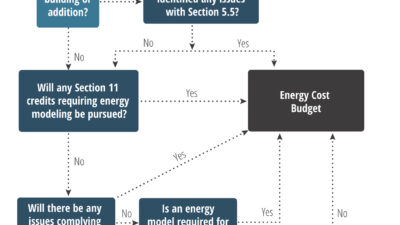Although natural daylight can offer significant energy savings, this can only be achieved with proper "harvesting" and integration into a dimming control system. This month's panel describes how to best specify sensors and control systems, along with other important issues of lighting design and technology.
Although natural daylight can offer significant energy savings, this can only be achieved with proper “harvesting” and integration into a dimming control system. This month’s panel describes how to best specify sensors and control systems, along with other important issues of lighting design and technology.
CONSULTING-SPECIFYING ENGINEER (CSE): What key technical aspects of a project must be in place in order to execute a successful daylight harvesting/control design?
BENYA: Each space should have a reasonable amount of horizontal illumination from daylight, preferably without glare, or with effective shading systems.
TRIVELY: This can be achieved with overhangs, light shelves and proper window glazing. High-performance window glazing can be designed to reflect a high percentage of infrared and ultraviolet light while passing light in the visible range.
SIERLEJA: In considering a daylighting scheme, a study should be conducted first of the local utilities rate structure, as well as a realistic look at the daylighting opportunity for the building. An estimate of how much energy can be saved and the potential impact on the bill should also be evaluated before a significant investment is made.
NORTH: [As Mr. Trively noted,] coordination with architectural finishes and window treatments, especially ceiling construction, glazing and shading devices, is key. The application needs the ability to zone lighting on a parallel path to the natural light entering the space. Usually this means in rows adjacent to the windows, but it could also mean a circular pattern near a skylight. Also, appropriate space needs to be allocated to house control equipment, and a suitable, yet functional location must be identified for the photosensor.
CSE: How does building siting come into play?
BENYA: In all respects—solar luminance (brightness), ground luminance, building luminance and daily/annual solar pattern relative to fenestration. Siting fundamentally determines the extent to which daylighting and controls will work.
NORTH: East and west exposures are the most problematic because of direct sun at low horizon angles during typical business hours. Direct solar glare complicates the equation and affects the behavior of the occupants, particularly in regard to manually-operated window treatments. North facades offer the most trouble-free conditions because there is no direct sun, and proper horizontal shielding, via overhangs, can protect interiors against direct sun on southern facades.
BIERMAN: Surrounding landscape also affects daylight availability. For example, open vs. wooded landscape, and the height of surrounding buildings must be considered.
SIERLEJA: Another important factor to consider is if a building is hidden within a city skyline, such as in Manhattan, where there’s a good chance usable daylight will be hard to find.
CSE: What are some common pitfalls associated with designing and specifying daylighting and dimming control systems?
SIERLEJA: Glare is a big one. Direct sunlight through a window or a very high luminance on a bright office wall is distracting and fatiguing. In addition, be aware of the effect on heating and air conditioning. Don’t waste all energy savings from more efficient lighting on additional heating or cooling requirements due to temperature fluctuations through windows or skylights.
NORTH: Another common pitfall is assuming that simply indicating the need for photosensor control on the plans or specifications is enough. Photosensor placement, combined with its control algorithm, is a critical element for a functional system. Open-loop and closed-loop control-strategy systems require different parameters for photosensor placement.
But probably the greatest pitfall is a lack of proper commissioning after installation. As a specifier, it is imperative to require that the system be commissioned in a manner consistent with the design and the manufacturers’ parameters.
TRIVELY: I agree, especially starting the calibration and commissioning process before people and furniture are in place.
Other common pitfalls involve:
-
Not considering the role of manual or motorized window shades and sun screens as a way to control direct sunlight.
-
Not separately zoning and circuiting fluorescent lighting fixtures parallel to the windows.
-
Not making one vendor responsible for the compatibility of the lamps, ballasts, photosensors and dimming controls.
CSE: What types of lamps are most ideal for dimming?
SIERLEJA: F32T8 and four-pin compact-fluorescent lamps (CFLs).
BIERMAN: Both linear lamps—T5 and T8—and CFLs are readily dimmable; however, some of the low wattage CFLs have more limited dimming ranges and can be extremely sensitive to lamp-to-ballast wiring techniques for reliable performance. The life and reliability of fluorescent lamps when operated at dimmed levels is still questionable.
SIERLEJA: But in an office or large building, these are the primary light sources and represent the greatest energy-savings opportunity.
BIERMAN: When combined with electronic dimming ballasts, I’ll admit that fluorescent lighting maintains high luminous efficiency, nearly constant color quality and steady, flicker-free operation when dimmed—even to levels below 25% full power.
Beside CFLs, high-intensity discharge (HID) light sources can be dimmed, but the range is limited to about 50% energy savings.
BENYA: But HID lamps do not dim well and efficacy falls when dimmed. A new metal-halide electronic dimming ballast improves HID dimming somewhat, but HID does not enjoy the linear light-to-power ratio of fluorescent over the useful 20% to 100% range.
BIERMAN: Metal-halide lamps themselves can also be dimmed, but they take on the qualities of mercury-vapor lamps when dimmed, and high-pressure sodium starts to become more like low-pressure sodium. Of course, incandescent lamps can also be dimmed easily, but the low efficacy often makes it an inappropriate choice for general illumination. Additionally, the need to dim accent or task lighting in response to daylight is questionable.
CSE: What are the main aspects of performance and operation that must be considered when specifying photosensors and dimming controls?
NORTH: The main points have to do with the photosensor response characteristics, control algorithm, ballast protocol and system adjustments. As for photosensors, there are three input response parameters to check: intensity range, spatial response and spectral response.
The control algorithm is the heart of the system since it defines program parameters including: set points to define on/off limits; dead bands to prevent on/off loops; fade/ramp rates to minimize occupant discomfort; reaction time delays to compensate for moving cloud cover; and minimum run-times to prevent short cycling, particularly with HID lamps. Carefully mating the logical “what-if” scenarios of the application and the control algorithm are key to a successful system.
BIERMAN: Unfortunately, most photosensors are not characterized well enough by manufacturers to enable a totally informed decision to be made. Most photosensors on the market use either integral control—also called reset control—or some type of proportional control. Generally, proportional control is much more flexible, provided that it has the appropriate user adjustment capabilities. Integral control works best for lumen maintenance without daylight.
TRIVELY: System compatibility and performance is a must. Dimming should be smooth and stable with no flicker.
Other important factors, like dimming range, ballast factor, power factor and total harmonic distortion, are similar among the major manufacturers. Look for manufacturers with a proven track record for quality and with the reputation of being able to quickly resolve problems with any part of the system.
Also, photo-sensor calibration adjustment should be located away from the sensor to avoid shielding the sensor during adjustment.
SIERLEJA: Besides making sure all the elements work together, be sure that a simple, manual override system is in place. That way, when the lights absolutely need to be on, they’re easy to turn on and adjust.
CSE: What kinds of problems might one come across when matching up sensors, controls, lamps and ballasts?
BENYA: There are six main major circuit types:
-
Analog three-wire forward phase-cut (Lutron, Lightolier).
-
Analog four-wire zero- to 10-volt or 1- to 10-volt (most manufacturers).
-
Analog two-wire forward phase-cut (Lutron, Advance).
-
Analog two-wire, reverse phase-cut (ESI).
-
Digital Addressable Lighting Interface (DALI).
-
ESI digital.
There is no compatibility among these systems, so it is not a solution to simply specify digital or analog systems.
Secondary incompatibilities include the inconsistent behavior when connecting supposedly “generic” ballasts, especially zero- to 10-volt to generic dimming controllers.
BIERMAN: Different zero- to 10-volt ballasts have different dimming response curves and threshold voltages supporting on/standby functions. Line voltage phase-chop dimming products suffer similar uncertainties. If the designer is not going to one manufacturer for a complete system, test for compatibility before specifying a system.
SIERLEJA: The problem I hear the most about is the sensor supplying a signal or voltage that the ballast doesn’t understand. Be certain that the ballast is compatible with the sensor. Check with the lamp manufacturer and make certain that the lamps are dimmable. Some of the newer energy-saving lamps are great on standard ballasts, but aren’t recommended for use on dimming systems.
NORTH: Daylighting controls need to be thought of as a system, not a sequence of mix-and-match parts. Although it is possible to mix-and-match a system, it’s always desirable to have a single entity take responsibility for the overall system. This greatly simplifies commissioning and trouble-shooting.
CSE: Why isn’t the use of photosensors and dimming systems more widespread in the United States?
NORTH: Simply put, initial cost and inertia. Many clients talk the talk, but when it becomes a choice between a daylight dimming system and marble flooring in the lobby, the daylight harvesting system is often the victim.
BIERMAN: There are also technical and economic barriers. Fluorescent and HID dimming technology has not been developed to the point where it is a robust, mature technology. And on the economic side, there has not been much of a market pull for dimming products, for energy savings or electrical demand reductions.
In places where dimming is used for other purposes, such as in conference rooms and multimedia spaces, dimming is well established. But products that are used in these types of spaces do not make economic sense for general lighting in offices, schools and factories.
CSE: What are some of the more recent technological advances in photosensors and dimming controls?
BIERMAN: All controls are benefiting from advances in digital electronics and communications in other fields. It is now possible to have microprocessors in lighting control units that cost $20 or less and can carry out sophisticated control algorithms and communication protocols. Case in point, the Lighting Research Center at the Rensselaer Polytechnic Institute, in Troy, N.Y., has developed a microprocessor-based, virtually self-commissioning photosensor for offices that uses a wireless sensor. This technology, while available 10 years ago, was not at a low enough price, nor sufficiently small or efficient enough to make a viable product. Now it can be made from off-the-self components.
SIERLEJA: There’s a great deal being done with communication standards. This will solve many of the compatibility issues. In addition, dimming ballasts are constantly improving.
NORTH: I have high hopes for DALI-based daylighting systems in the United States because of their inherent adaptability and fine-tuning capabilities. [DALI is a relatively new control scheme that communicates with electronic ballasts via a digital address. See “DALI Delivers Control and Cost Savings, Headaches Too,” on p. 12 of CSE’s June issue.] Our office is currently working with the Watt Stopper to develop a DALI control algorithm for a particularly difficult daylighting application project.
BENYA: I am thrilled that Lutron and perhaps some other companies are now making shading system controls capable of being integrated into networked, programmable daylight dimming systems. This represents a quantum leap in thinking and ushers in a new era in the control of light for interior space.
Participants
James R. Benya, P.E., IALD, Benya Lighting Design, West Linn, Ore.
Andrew C. Bierman, Lighting Systems Specialist, Lighting Research Center, Rensselaer Polytechnic Institute, Troy, N.Y.
Leslie North, P.E., Lighting Design Practice Leader, OWP&P, Chicago
Roy Sierleja, Senior Product Specialist, G.E. Lighting Institute, Cleveland
Paul Trively, Vice President of Specification Sales, Lutron, Coopersburg, Penn.
Daylighting Payback—Beyond Energy
Lighting retrofits usually demonstrate attractively fast paybacks, but what about introducing daylighting into new construction or renovations?
As long as the daylighting apertures are designed to control glare and lighting controls allow for daylight harvesting by a proportional reduction in electric lighting, kWh savings will result. But this is only the beginning of the savings, and probably the least significant of the financial benefits.
For example, because daylight is the “coolest” form of light available for practical use in interior area illumination, more lumens of light per BTU of heat through glass is extracted than from the best fluorescent lighting systems on the market—by a factor of two. And less than 1% of the intensity of sunlight is sufficient to provide all of the necessary interior lighting intensity. Therefore, cooling systems in well-daylit environments won’t work as hard, thereby saving cooling energy, while also reducing cooling system maintenance and prolonging life. Those savings go straight to the building owner’s bottom line.
In addition, when the daylighting systems are designed at the same time as HVAC, other cost-savings can often accrue, such as installing smaller units.
However, the most important savings have little to do with these mechanical benefits. When the electricity goes off and lights go out, people in daylit offices can continue to work. Since the cost per sq. ft. of personnel is approximately 100 to 150 times the cost per sq. ft. for energy, even a few hours of work in each year that might otherwise be lost can often pay for all of the costs of the original daylighting measures.
By Donald W. Aitken, Ph.D., Technical Consultant, Daylighting Collaborative, Energy Center of Wisconsin, Madison, Wis.
The Inside Scoop on Photosensors
Consider the following when choosing a photosensor, keeping in mind that different manufacturers’ algorithms have their own unique guidelines:
Is it open-loop or closed-loop control? Will the photosensor “see” the light that it is controlling? If it will, such as a ceiling mounted photosensor, choose a photosensor suitable for closed-loop control.
Are there skylights or vertical windows? With skylights, a simpler integral control algorithm may suffice. For vertical windows, the distribution of light from daylight and electric sources is typically much different, necessitating a closed-loop proportional control algorithm with lots of adjustability.
What is the range of response? Make sure the photosensor can handle the range of light levels likely to be encountered.
What is the spectral response? Be aware that most photosensors have greater sensitivity to daylight than to fluorescent illumination. Choose a sensor with proper filtering to reject the infrared and ultraviolet components of daylight. For open-loop control, spectral response is not as important.
What is the spatial response? In general, choose a wide view spatial response. This makes the sensor less sensitive to movement and activity in the space, and provides a signal that is representative of the overall level of illumination.
By Andrew Bierman, Lighting Research Center, Rensselaer Polytechnic Institute, Troy, N.Y.
Key Resources at a Glance
When seeking out resources to assist with daylighting projects, the following associations and programs may prove useful:
Lighting Research Center at Rensselaer, National Lighting Product Information Program,
Pacific Gas and Electric Company Daylighting Initiative,
Lawrence Berkeley National Laboratory Windows and Daylighting Group,
Energy Center of Wisconsin, Daylighting Collaborative,
Northwest Energy Efficiency Alliance, Lighting Design Lab,
U.S. Green Buildings Council,
Advanced Lighting Guidelines,



